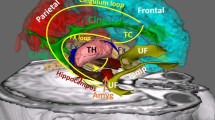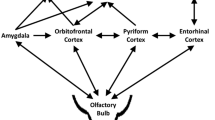Abstract
Multiple chemical sensitivity (MCS) patients usually react to odour compounds and the majority of neuroimaging studies assessed, especially at the cortical level, many olfactory-related correlates. The purpose of the present study was to depict sub-cortical metabolic changes during a neutral (NC) and pure (OC) olfactory stimulation by using a recently validated 18F-2-fluoro-2-deoxy-d-glucose (FDG)-positron emission tomography/computer tomography procedure in 26 MCS and 11 healthy (HC) resting subjects undergoing a battery of clinical tests. Twelve subcortical volumes of interest were identified by the automated anatomical labeling library and normalized to thalamus FDG uptake. In both groups, when comparing OC to NC, the within-subjects ANOVA demonstrated a relative decreased metabolism in bilateral putamen and hippocampus and a relative increased metabolism in bilateral amygdala, olfactory cortex (OLF), caudate and pallidum. The between-groups ANOVA demonstrated in MCS a significant higher metabolism in bilateral OLF during NC. As in HC subjects negative correlations were found in OC between FDG uptake in bilateral amygdala and hippocampus and odor pleasantness scale, the latter positively correlated with MCS subjects’ bilateral putamen FDG uptake in OC. Besides FDG uptake resemblances in both groups were found, for the first time a relative higher metabolism increase in OLF in MCS subjects at rest with respect to HC was found. When merging this aspect to the different subcortical FDG uptake correlations patterns in the two groups, the present study demonstrated to describe a peculiar metabolic index of behavioral and neurological aspects of MCS complaints.



Similar content being viewed by others
References
Åhs F, Miller SS, Gordon AR, Lundström JN (2013) Aversive learning increases sensory detection sensitivity. Biol Psychol 92:135–141
Alessandrini M, Micarelli A, Bruno E, Ottaviani F, Conetta M, Cormano A, Genovesi G (2013a) Intranasal administration of hyaluronan as a further resource in olfactory performance in multiple chemical sensitivity syndrome. Int J Immunopathol Pharmacol 26:1019–1025
Alessandrini M, Pagani M, Napolitano B, Micarelli A, Candidi M, Bruno E et al (2013b) Early and phasic cortical metabolic changes in vestibular neuritis onset. PLoS One 8:e57596
Alessandrini M, Micarelli A, Chiaravalloti A, Candidi M, Bruno E, Di Pietro B, Schillaci O, Pagani M (2014a) Cortico-subcortical metabolic correlates of olfactory processing in healthy resting subjects. Sci Rep 4:5146
Alessandrini M, Micarelli A, Chiaravalloti A et al (2014b) Cerebellar metabolic involvement and its correlations with clinical parameters in vestibular neuritis. J Neurol 261:1976–1985
Anderson AK, Christoff K, Stappen I, Panitz D, Ghahremani DG, Glover G, Gabrieli JD, Sobel N (2003) Dissociated neural representations of intensity and valence in human olfaction. Nat Neurosci 6:196–202
Andersson L, Bende M, Millqvist E, Nordin S (2009) Attention bias and sensitization in chemical sensitivity. J Psychosom Res 66:407–416
Andersson L, Claeson AS, Nyberg L, Stenberg B, Nordin S (2014) Brain responses to olfactory and trigeminal exposure in idiopathic environmental illness (IEI) attributed to smells—an fMRI study. J Psychosom Res 77:401–408
Anonymous (1999) Multiple chemical sensitivity: a 1999 consensus. Arch Environ Health 54:147–149
Azuma K, Uchiyama I, Takano H, Tanigawa M, Azuma M, Bamba I, Yoshikawa T (2013) Changes in cerebral blood flow during olfactory stimulation in patients with multiple chemical sensitivity: a multi-channel near-infrared spectroscopic study. PLoS One 8:e80567
Bascom R, Meggs WJ, Frampton M, Hudnell K, Killburn K, Kobal G, Medinsky M, Rea W (1997) Neurogenic inflammation: with additional discussion of central and perceptual integration of nonneurogenic inflammation. Environ Health Perspect 105:S531–537
Bell IR, Miller CS, Schwartz GE (1992) An olfactory-limbic model of multiple chemical sensitivity syndrome: possible relationships to kindling and affective spectrum disorders. Biol Psychiatry 32:218–242
Benjamin C, Lieberman DA, Chang M, Ofen N, Whitfield-Gabrieli S, Gabrieli JD, Gaab N (2010) The influence of rest period instructions on the default mode network. Front Hum Neurosci 4:218
Bitter T, Gudziol H, Burmeister HP, Mentzel HJ, Guntinas-Lichius O, Gaser C (2010) Anosmia leads to a loss of gray matter in cortical brain areas. Chem Senses 35:407–415
Carmichael ST, Clugnet MC, Price JL (1994) Central olfactory connections in the macaque monkey. J Comp Neurol 346:403–434
Carpenter RHS (2003) Neurophysiology. Arnold, London
Cavanna AE (2007) The precuneus and consciousness. CNS Spectr 12:545–552
Chiaravalloti A, Pagani M, Micarelli A, Di Pietro B, Genovesi G, Alessandrini M, Schillaci O (2015) Cortical activity during olfactory stimulation in multiple chemical sensitivity: a 18F-FDG PET/CT study. Eur J Nucl Med Mol Imaging 42:733–740
Corbetta M, Shulman GL (2002) Control of goal-directed and stimulus-driven attention in the brain. Nat Rev Neurosci 3:201–215
Cullen MR (1987) The worker with multiple chemical sensitivities: an overview. Occup Med State Art Rev 2:655–661
Dantoft TM, Elberling J, Brix S, Szecsi PB, Vesterhauge S, Skovbjerg S (2014) An elevated pro-inflammatory cytokine profile in multiple chemical sensitivity. Psychoneuroendocrinology 40:140–150
Das-Munshi J, Rubin GJ, Wessely S (2006) Multiple chemical sensitivities: a systematic review of provocation studies. J Allergy Clin Immunol 118:1257–1264
Das-Munshi J, Rubin GJ, Wessely S (2007) Multiple chemical sensitivities: review. Curr Opin Otolaryngol Head Neck Surg 15:274–280
De Luca M, Beckmann CF, De Stefano N, Matthews PM, Smith SM (2006) fMRI resting state networks define distinct modes of long-distance interactions in the human brain. NeuroImage 29:1359–1367
Déjerine JJ (1980) Anatomie des centres nerveux. Masson, Paris
Dosenbach NU, Fair DA, Miezin FM, Cohen AL, Wenger KK, Dosenbach RA, Fox MD, Snyder AZ, Vincent JL, Raichle ME, Schlaggar BL, Petersen SE (2007) Distinct brain networks for adaptive and stable task control in humans. Proc Natl Acad Sci USA 104:11073–11078
Gottfried JA (2006) Smell: central nervous processing. In: Hummel T, Welge-Lüssen A (eds) Taste and Smell. An Update, Karger, Basel, pp 44–69
Haruno M, Kawato M (2006) Different neural correlates of reward expectation and reward expectation error in the putamen and caudate nucleus during stimulus-action-reward association learning. J Neurophysiol 95:948–959
Hillert L, Musabasic V, Berglund H, Ciumas C, Savic I (2007) Odor processing in multiple chemical sensitivity. Hum Brain Mapp 28:172–182
Hillert L, Jovanovic H, Åhs F, Savic I (2013) Women with multiple chemical sensitivity have increased harm avoidance and reduced 5-HT(1A) receptor binding potential in the anterior cingulate and amygdala. PLoS One 8:e54781
Hudry J, Perrin F, Ryvlin P, Mauguiere F, Royet JP (2003) Olfactory short-term memory and related amygdala recordings in patients with temporal lobe epilepsy. Brain 126:1851–1863
Kadohisa M (2013) Effects of odor on emotion, with implications. Front Syst Neurosci 7:66
Kärnekull SC, Jönsson FU, Larsson M, Olofsson JK (2011) Affected by smells? Environmental chemical responsivity predicts odor perception. Chem Senses 36:641–648
Keller A (2011) Attention and olfactory consciousness. Front Psychol 2:380
Kobal G, Hummel T, Sekinger B, Barz S, Roscher S, Wolf S (1996) ‘‘Sniffin’ sticks’’: screening of olfactory performance. Rhinology 34:222–226
Kroupi E, Yazdani A, Vesin JM, Ebrahimi T (2012) Multivariate spectral analysis for identifying the brain activations during olfactory perception. Conf Proc IEEE Eng Med Biol Soc 2012:6172–6175
Lacour M, Zunder T, Schmidtke K, Vaith P, Scheidt C (2005) Multiple chemical sensitivity syndrome (MCS)—suggestions for an extension of the U.S. MCS-case definition. Int J Hyg Environ Health 208:141–151
Lombion-Pouthier S, Vandel P, Nezelof S, Haffen E, Millot JL (2006) Odor perception in patients with mood disorders. J Affect Disord 90:187–191
Magistretti PJ (2006) Neuron-glia metabolic coupling and plasticity. J Exp Biol 209:2304–2311
Mazoyer B, Zago L, Mellet E, Bricogne S, Etard O, Houdé O, Crivello F, Joliot M, Petit L, Tzourio-Mazoyer N (2001) Cortical networks for working memory and executive functions sustain the conscious resting state in man. Brain Res Bull 54:287–298
Nigri A, Ferraro S, D’Incerti L, Critchley HD, Bruzzone MG, Minati L (2013) Connectivity of the amygdala, piriform, and orbitofrontal cortex during olfactory stimulation: a functional MRI study. NeuroReport 24:171–175
Orriols R, Costa R, Cuberas G, Jacas C, Castell J, Sunyer J (2009) Brain dysfunction in multiple chemical sensitivity. J Neurol Sci 287:72–78
Pagani M, De Carli F, Morbelli S, Öberg J, Chincarini A, Frisoni GB, Caroli A, Perneczky R, Drzezga A, van Berckel BNM, Ossenkoppele R, Guedj E, Didic M, Brugnolo A, Picco A, Arnaldi D, Ferrara M, Buschiazzo A, Sambuceti G, Nobili F (2014) Region of interest-based [18F]fluorodeoxyglucose PET identification of patients with MCI due to Alzheimer disease and healthy controls. An European Alzheimer Disease Consortium (EADC) study. Neuroimage Clin 7:34–42
Pall ML (2003) Elevated nitric oxide/peroxynitrite theory of multiple chemical sensitivity: central role of N-methyl-D-aspartate receptors in the sensitivity mechanism. Environ Health Perspect 111:1461–1464
Qureshy A, Kawashima R, Imran MB, Sugiura M, Goto R, Okada K, Inoue K, Itoh M, Schormann T, Zilles K, Fukuda H (2000) Functional mapping of human brain in olfactory processing: a PET study. J Neurophysiol 84:1656–1666
Raichle ME, MacLeod AM, Snyder AZ, Powers WJ, Gusnard DA, Shulman GL (2001) A default mode of brain function. Proc Natl Acad Sci USA 98:676–682
Sakamoto N, Pearson J, Shinoda K, Alheid GF, de Olmos JS, Heimer L (1999) The human basal forebrain. Part I. An overview. In: Bloom FE, Bjorklund A, Hokfelt T (eds) Handbook of chemical neuroanatomy: the primate nervous system, Part III, vol 15. Elsevier, Amsterdam, pp 1–13
Savic I (2002) Brain imaging studies of the functional organization of human olfaction. Neuroscientist 8:204–211
Scarmeas N, Habeck CG, Zarahn E, Anderson KE, Park A, Hilton J, Pelton GH, Tabert MH, Honig LS, Moeller JR, Devanand DP, Stern Y (2004) Covariance PET patterns in early Alzheimer’s disease and subjects with cognitive impairment but no dementia: utility in group discrimination and correlations with functional performance. Neuroimage 23:35–45
Shulman GL, Fiez JA, Corbetta M, Buckner RL, Miezin FM, Raichle ME, Petersen SE (1997) Common blood flow changes across visual tasks. II. Decreasesin cerebral cortex. J Cogn Neurosci 9:648–663
Siegel S, Kreutzer R (1997) Pavlovian conditioning and multiple chemical sensitivity. Environ Health Perspect 2:521–526
Simopoulos E, Katotomichelakis M, Gouveris H, Tripsianis G, Livaditis M, Danielides V (2012) Olfaction-associated quality of life in chronic rhinosinusitis: adaptation and validation of an olfaction-specific questionnaire. Laryngoscope 122:1450–1454
Tomasi D, Volkow ND (2011) Association between functional connectivity hubs and brain networks. Cereb Cortex 9:2003–2013
Tzourio-Mazoyer N, Landeau B, Papathanassiou D, Crivello F, Etard O, Delcroix N, Mazoyer B, Joliot M (2002) Automated anatomical labelling of activations in SPM using a macroscopic anatomical parcellation of the MNI MRI single-subject brain. Neuroimage 15:273–289
Varrone A, Asenbaum S, Vander Borght T, Booij J, Nobili F, Någren K, Darcourt J, Kapucu OL, Tatsch K, Bartenstein P, Van Laere K, European Association of Nuclear Medicine Neuroimaging Committee (2009) EANM procedure guidelines for PET brain imaging using [18F]FDG, version 2. Eur J Nucl Med Mol Imaging 36:2103–2110
Vincent JL, Kahn I, Snyder AZ, Raichle ME, Buckner RL (2008) Evidence for a frontoparietal control system revealed by intrinsic functional connectivity. J Neurophysiol 100:3328–3342
Wang J, Eslinger PJ, Smith MB, Yang QX (2005) Functional magnetic resonance imaging study of human olfaction and normal aging. J Gerontol A 60:510–514
Winder C (2002) Mechanisms of multiple chemical sensitivity. Toxicol Lett 128:85–97
Winters W, Devriese S, Van-Diest I, Nemery B, Veulemans H, Eelen P, Van de Woestijne K, Van den Bergh O (2003) Media warnings about environmental pollution facilitate the acquisition of symptoms in response to chemical substances. Psychosom Med 65:332–338
Witthöft M, Gerlach AL, Bailer J (2006) Selective attention, memory bias, and symptom perception in idiopathic environmental intolerance and somatoform disorders. J Abnorm Psychol 115:397–407
Yeshurun Y, Sobel N (2010) An odor is not worth a thousand words: from multidimensional odors to unidimensional odor objects. Annu Rev Psychol 61:219–241
Zung WW, Gianturco JA (1971) Personality dimension and the Self-Rating Depression Scale. J Clin Psychol 27:247–248
Acknowledgments
The authors express sincerely thanks to MichelAngela Studio for skillful and creative craftsmanship in preparing illustrations.
Author information
Authors and Affiliations
Corresponding author
Ethics declarations
Conflicts of interest
On behalf of all authors, the corresponding author states that there are no conflicts of interest.
Rights and permissions
About this article
Cite this article
Alessandrini, M., Micarelli, A., Chiaravalloti, A. et al. Involvement of Subcortical Brain Structures During Olfactory Stimulation in Multiple Chemical Sensitivity. Brain Topogr 29, 243–252 (2016). https://doi.org/10.1007/s10548-015-0453-3
Received:
Accepted:
Published:
Issue Date:
DOI: https://doi.org/10.1007/s10548-015-0453-3




